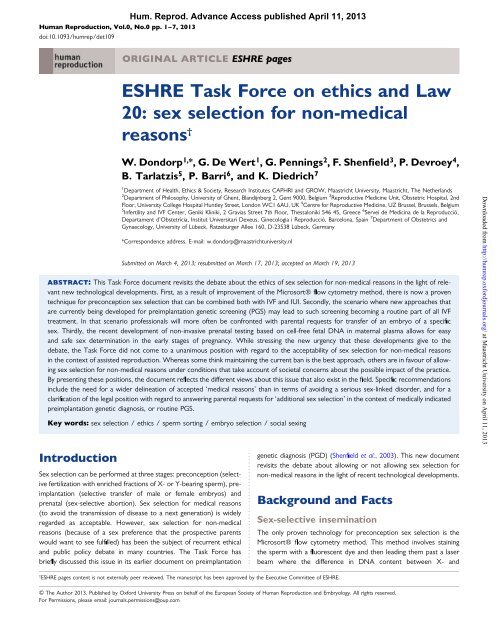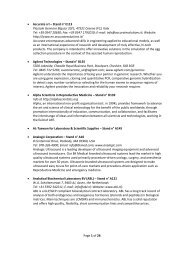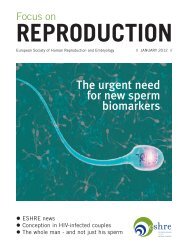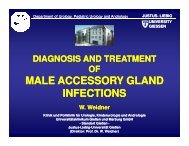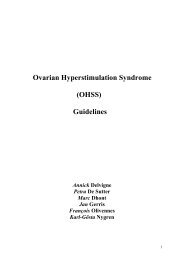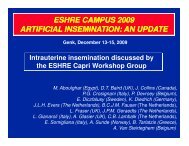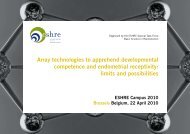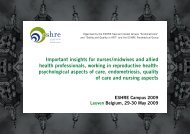sex selection for non-medical reasons - eshre
sex selection for non-medical reasons - eshre
sex selection for non-medical reasons - eshre
Create successful ePaper yourself
Turn your PDF publications into a flip-book with our unique Google optimized e-Paper software.
6 Dondorp et al.<strong>sex</strong> <strong>selection</strong>: allowing (preconception) <strong>sex</strong> <strong>selection</strong> in a trial settinginvolving proper pretreatment implications counselling and seriousmonitoring of all relevant aspects. Such a trial ‘would permit an assessmentto be made of the extent and profile of demand <strong>for</strong> this service,and controlled follow-up of families involved, including the effects of<strong>selection</strong> on the subsequent treatment and long-term psychologicaldevelopment of the children’ (HFEA, 2003). As a matter of caution,it would be advisable to use ‘family balancing’ as a condition <strong>for</strong>access to this trial, with the aim of neutralizing the most importantpotential dangers and disadvantages of unrestricted <strong>sex</strong> <strong>selection</strong>(Pennings, 1996).Recommendations(i) Sex <strong>selection</strong> should be allowed in principle if aimed at avoidingoffspring health risks. This not only includes <strong>sex</strong> <strong>selection</strong> toavoid the birth of a child with a <strong>sex</strong>-linked disorders such ashaemophilia or Duchenne muscular dystrophy, but (dependingon the proportionality of the procedure) also to reduce thechances of having a child affected by a disorder with anunequal <strong>sex</strong>-incidence, and <strong>for</strong> avoiding transgenerationalhealth risks.(ii) Centres offering flow sorting should commit themselves tocareful monitoring and follow-up in order to provide data <strong>for</strong>assessing the longer term safety of the technology. As part ofin<strong>for</strong>med consent, prospective parents should be clearlyin<strong>for</strong>med that safety data are still limited and that spermsorting through flow cytometry is not yet an established technology.In cases where the technology is not used as a pre<strong>selection</strong>step <strong>for</strong> IVF/PGD, prospective parents should be well in<strong>for</strong>medabout the limited reliability of the technique.(iii) The advent of NIPT may become an easy alternative route <strong>for</strong>those wanting <strong>sex</strong> <strong>selection</strong> <strong>for</strong> <strong>non</strong>-<strong>medical</strong> <strong>reasons</strong>. As <strong>sex</strong>selectiveabortion is a morally more problematic method <strong>for</strong><strong>sex</strong> <strong>selection</strong> than the methods that in most countries are notallowed <strong>for</strong> this purpose, this should be a concern <strong>for</strong> professionalsand policy-makers, precisely because this alternativeroute would be difficult to regulate or control.(iv) If the present ban on <strong>sex</strong> <strong>selection</strong> <strong>for</strong> <strong>non</strong>-<strong>medical</strong> <strong>reasons</strong> is tobe maintained, clarification is needed as to whether it applies tofulfilling parental requests <strong>for</strong> additional <strong>selection</strong> in the contextof a <strong>medical</strong>ly indicated IVF/PGD (or PGS) procedure. Dependingon the precise wording of the ban in different countries, additional<strong>selection</strong> (not involving any extra procedures or use oftechniques) may or may not be against the letter of the law. Professionalsneed to know what the legal position is with regard toanswering such requests.(v) If the arguments against a categorical ban are found convincing,there would still be a need <strong>for</strong> setting conditions defining the responsibleuse of <strong>sex</strong> <strong>selection</strong> <strong>for</strong> <strong>non</strong>-<strong>medical</strong> <strong>reasons</strong>. A cautiousapproach would be to allow preconception <strong>sex</strong> <strong>selection</strong><strong>for</strong> family balancing in a setting designed to gain further dataabout all relevant aspects. The family-balancing requirementcould be set at having at least one or at least more than onechild of the <strong>non</strong>-requested <strong>sex</strong> in the household. Under thesame family-balancing condition, professionals should then alsobe allowed to fulfil requests <strong>for</strong> additional <strong>sex</strong> <strong>selection</strong> afterPGD or PGS, in cases where there are embryos of both <strong>sex</strong>esand in which the choice between those embryos is not fullydetermined by <strong>medical</strong> criteria.FundingThis work was funded by the European Society of Human Reproductionand Embryology (ESHRE).Conflict of interestNone declared.ReferencesAmerican Society Reproductive Medicine Ethics Committee. Sex <strong>selection</strong>and preimplantation genetic diagnosis. Fertil Steril 1999;72:595–598.Bredenoord AL, Dondorp W, Pennings G, De Wert G. Avoidingtransgenerational risks of mitochondrial DNA disorders: a morallyacceptable reason <strong>for</strong> <strong>sex</strong> <strong>selection</strong>? Hum Reprod 2010;25:1354–1360.Council of Europe, Parliamentary Assembly. Resolution 1829: <strong>sex</strong><strong>selection</strong>, 2011 http://assembly.coe.int/Main.asp?link=/Documents/AdoptedText/ta11/ERES1829.htm (3 March 2013, date last accessed).Dahl E, Beutel M, Brosig B, Grüssner S, Stöbel-Richter Y, Tinneberg HR,Brähler E. Social <strong>sex</strong> <strong>selection</strong> and the balance of the <strong>sex</strong>es: empiricalevidence from Germany, the UK, and the US. J Assist Reprod Genet2006;23:311–318.Darnovsky M. Countries with laws or policies on <strong>sex</strong> <strong>selection</strong>. In: Memo<strong>for</strong> the April 13 New York City Sex Selection Meeting, 2009 http://geneticsandsociety.org/downloads/200904_<strong>sex</strong>_<strong>selection</strong>_memo.pdf(3 March 2013, date last accessed).De Geyter C, Sterthaus O, Miny P, Wenzel F, Lapaire O, De Geyter M,Sartorius G. First successful pregnancy in Switzerland after prospective<strong>sex</strong> determination of the embryo through the separation ofX-chromosome bearing spermatozoa. Swiss Med Wkly 2013;143:w13718.De Wert G. Preimplantation genetic diagnosis: the ethics of intermediatecases. Hum Reprod 2005;20:3261–3266.Devaney SA, Palomaki GE, Scott JA, Bianchi DW. Noninvasive fetal <strong>sex</strong>determination using cell-free fetal DNA: a systematic review andmeta-analysis. JAMA 2011;306:627–636.Dickens BM, Serour GI, Cook RJ, Qiu RZ. Sex <strong>selection</strong>: treating differentcases differently. Int J Gynaecol Obstet 2005;90:171–177.FIGO (International Federation of Gynecology and Obstetrics). Resolutio<strong>non</strong> ‘<strong>sex</strong> <strong>selection</strong> <strong>for</strong> <strong>non</strong>-<strong>medical</strong> purposes’ adopted by the FIGOGeneral Assembly on 7th November, 2006. http://www.figo.org/projects/<strong>sex</strong>_<strong>selection</strong> (3 March 2013, date last accessed).Garner DL. Hoechst 33342: The dye that enabled differentiation of livingX- and Y-chromosome bearing mammalian sperm. Theriogenology 2009;71:11–21.Guilmoto CZ. The <strong>sex</strong> ratio transition in Asia. Popul Dev Rev 2009;35:519–549.Harper JC, Wilton L, Traeger-Synodinos J, Goossens V, Moutou C,SenGupta SB, Pehlivan Budak T, Renwick P, De Rycke M, Geraedts JPet al. The ESHRE PGD Consortium: 10 years of data collection. HumReprod Update 2012;18:234–247.Human Fertilisation & Embryology Authority. Sex <strong>selection</strong>: options <strong>for</strong>regulation. A report on the HFEA’s 2002–2003 review of <strong>sex</strong>Downloaded from http://humrep.ox<strong>for</strong>djournals.org/ at Maastricht University on April 11, 2013
Sex-<strong>selection</strong> <strong>for</strong> <strong>non</strong>-<strong>medical</strong> <strong>reasons</strong> 7<strong>selection</strong> including a discussion of legislative and regulatory options.London: HFEA, 2003.Hvistendahl M. Unnatural Selection. Choosing Boys over Girls, and theConsequences of a World Full of Men. New York: Public affairs, 2011.Karabinus DS. Flow cytometric sorting of human sperm: MicroSort clinicaltrial update. Theriogenology 2009;71:74–79.Pennings G. Family balancing as a morally acceptable application of <strong>sex</strong><strong>selection</strong>. Hum Reprod 1996;11:2339–2343.Pennings G. Personal desires of patients and social obligations ofgeneticists: applying preimplantation genetic diagnosis <strong>for</strong> <strong>non</strong>-<strong>medical</strong><strong>sex</strong> <strong>selection</strong>. Prenat Diagn 2002;22:1123–1129.Pennings G, de Wert G, Shenfield F, Cohen J, Tarlatzis B, Devroey P.ESHRE Task Force on Ethics and Law 13: the welfare of the child in<strong>medical</strong>ly assisted reproduction. Hum Reprod 2007;22:2585–2588.Shenfield F, Pennings G, Devroey P, Sureau C, Tarlatzis B, Cohen J; ESHREEthics Task Force. Task<strong>for</strong>ce 5: preimplantation genetic diagnosis. HumReprod 2003;18:649–651.Van Balen F. Attitudes towards <strong>sex</strong> <strong>selection</strong> in the Western world. PrenatDiagn 2006;26:614–618.WHO. Preventing gender-biased <strong>sex</strong> <strong>selection</strong>. Geneva: World HealthOrganization, 2011. http://whqlibdoc.who.int/publications/2011/9789241501460_eng.pdf (3 March 2013, date last accessed).Downloaded from http://humrep.ox<strong>for</strong>djournals.org/ at Maastricht University on April 11, 2013


